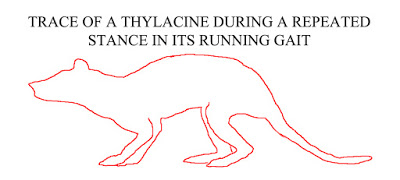Day thylacine - Moonta sunrise - gait analysis
Brendan Kays
On July 5th, 2017, you-tuber Paul Day uploaded a video to his channel "AuthorPaulGDay" titled "Could This Be A Tasmanian Tiger".
While out filming a sunrise, Paul captured an animal running across a field, at first he just thought it was a fox or dog, but later thought he may have captured rare footage of a thylacine.
It is easy to see why one would ponder this theory, the animal appears to have an unusual gait, a skipping motion not too dissimilar to the gait attributed to the thylacine, an animal that is officially presumed extinct.
Unfortunately, due to copyright reasons, my enhancement of the video can not be added to this blog, however I can provide a link to Paul's original video HERE
For my own private research, I ran this footage through video editing software. Through this process I was able to zoom in on the animal, and make the view angle follow the animal across the field, at a zoom level which allowed a good understanding of how this animal was using its limbs. This observation was made easier by being able to slow the footage down considerably.
Before jumping to a conclusion that it was a thylacine, which was very tempting given the unusual gait (I was nearly convinced it could be), I had too rule out other possibilities. The most plausible explanation, given that the thylacine is thought to have been extinct on the mainland for at least 2000 years, was that the animal was a canidae with some kind of disability. The canidae family includes foxes and dogs
This list of disabilities was worked through until I came upon the condition of Hip Dysplasia, this condition is particularly prevalent in German Shepherds, an animal very similar in build to the animal in the video.
Firstly, let's analyse the gait attributed to a thylacine when running, an animation showing this gait can be seen HERE on the naturalworlds website. You will see that a thylacine uses its back legs in unison to spring into a leap, landing on its front legs, which work almost in unison to pull it forward until the back legs are in position to propel it forward again, this is similar to other quadrupedic marsupials.
However on close examination the animal in Paul's video does not use its limbs in unison, rather its gait matches a canidae suffering from Hip Dysplasia. View a German Shepherd with Hip Dysplasia running in this video HERE from youtube.
Like the dog in the afore mentioned video, you will see that the animal in Paul's video is not using its front legs in unison, it lands on one and then follows with the other. The front legs can appear shorter than the rear, due to the fact the animal is placing most of its wait on the front legs to minimise the pain in its hip.
More telling is the way the animal is using its rear legs. The animal is holding the limb connected to the affected hip off the ground completely, forcing it to spring off the un-affected leg, this is what appears to make the gait look similar to a thylacine, especially when viewing without sufficient magnification.
In fact the gait of the animal is typical of a dog with Hip Dysplasia at a full run. Another observation of note is that the ears appear to flop up and down, this is not fitting with the short stiff ears of a thylacine.
While I hold out hope that a population of thylacines is hiding out in a remote part of Tasmania, maybe even Mainland Australian or New Guinea, I believe that the animal in Paul's video is far more likely to be a canidae suffering from Hip Dysplasia, especially given the above mentioned observations.
Post script
I am receiving some great feedback on this analyses, it is clear that this theory does not put the issue of this animal's identity to rest.
Paul Day has made the good point that the animation linked above is only an educated guess at how the Thylacine ran. He commented that "Early descriptions of the Thylacine stated that it ran with an unusual, irregular, even clumsy gait".
This footage HERE of a quoll running has been bought to my attention, which shows this distantly related marsupial using its front legs in a very similar way to the animal in Paul's video.
Interestingly, in 1973 an animal was filmed in South Australia which could possibly show a thylacine (The Doyle Footage). It has a gait matching exactly to the gait suggested in the animation on Natural World's website (linked above), an animation that is based on a lot of research. If we take the Doyle footage to be a Thylacine, that would make the animation a near perfect demonstration of how the thylacine ran in the wild. The jury is out on whether the Doyle footage is a thylacine. You can see the Doyle footage HERE. The gait is markedly different to that of the animal in Paul's video.
The mystery continues...

